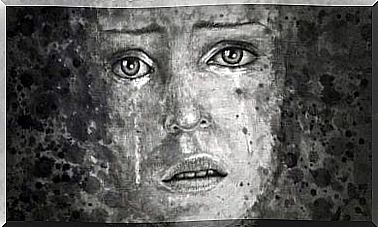Defense Mechanisms For Neurotic And Psychotic Patients

Defense mechanisms are automatic psychological processes. They protect you from anxiety and the perception of internal / external dangers or stressors. Defense mechanisms are the intermediary between the individual response to emotional conflict and external stressors. Read on to learn more about defense mechanisms for neurotic and psychotic patients.
While neurosis and psychosis sometimes “match”, the mechanisms that drive them are different. The difference lies in the relationship between reality and the way you construct reality. With neurosis, for example, imagination is a response to fixation. With psychosis on the other hand, it is a complete replacement that seeks to regain what was initially denied.
Defense mechanisms for neurotic patients
Oppression
This is when the mind prevents thoughts that create anxiety from entering the consciousness. It is the most basic defense mechanism and is always the first to emerge.
Displacement
Repression is when you replace your anxiety-producing and intolerable desire with something else that is acceptable and does not lead to anxiety. This defense mechanism can explain sudden phobias. For example, if you feel dirty and are embarrassed to say so, you can express disgust and fear of cockroaches instead.
Defense mechanisms for neurotic people based on identification
Identification
This psychic process involves the tendency to increase feelings of personal value by acquiring the traits of someone you admire.
Defense mechanisms for neurotic patients: Projective identification
Melanie Klein described this defense mechanism as the fantasies in which the subject puts himself into (in whole or in part) another object to control, damage or own it.
Identification with the attacker
Anna Freud and Ferenczi wrote about this mechanism. Here the subject absorbs some traits of the person that lead to anxiety for them. They go from being a victim to being an attacker.
Defense mechanisms for neurotic patients: Projection
This mechanism involves the individual projecting their own unrecognized and anxiety-producing traits onto other people or objects. This defense mechanism is found in psychosis, neurosis and perversions.
Introjection
Ferenczi described this defense mechanism as the individual acquiring the traits or beliefs of others without thinking about who they really are or what they actually believe in. For example, someone with depression may acquire someone else’s attitudes and preferences.
The “healthy” version of this would be identification. Identification involves acquiring aspects of others that you find desirable. Introjection, on the other hand, is like swallowing without chewing and the result is internal conflict.
Defense mechanisms based on impulse transformation
Defense mechanisms for neurotic patients: Formation of reaction
This defense mechanism is where an individual suppresses “unacceptable” thoughts and expresses them through contradictions. This explains mania, which hides behind repressed depression.
Substitution
The mechanism by which one suppresses a perversion and replaces it with something more acceptable. In this way one can satisfy one’s forbidden pleasure in secret. For example, a person who is not turned on by his partner, but who can not accept it, can suppress this feeling and express it in the form of an allergic reaction.
Defense mechanisms for neurotic: Sublimation
This mechanism seeks to replace an unacceptable object or activity with one with a higher social or ethical value.
Rationalization
The rational justification of thoughts or behaviors that produce anxiety. This is different from intellectualization as there is no systematic avoidance of the effects. Instead, the individual attributes more motivations that are more likely than true, giving them a rational or ideal justification.
Defense mechanisms for neurotic: Intellectualization
The individual tries to give a logical formation to the conflicts and their emotions to control them. It combines the emotional isolation of painful events a rational explanation.
Defense mechanisms for neurotic patients that mask or suppress impulses
Insulation
This mechanism causes the individual to isolate certain outrageous thoughts or feelings from each other. That way, they are still conscious of their thoughts and feelings, but they lack all associative connections. For example, a child may feel anxious because they are a victim of abuse, but they are unable to see the relationship between anxiety and abuse.
Defense mechanisms for neurotic patients: Compromise formation
Consciousness forms a repressed idea or desire that has been changed or disguised. It can manifest itself in three ways: dreams, symptoms and certain types of artistic forms of expression.
Regret
According to Freud, this is when an individual actively tries to change or regret what has already been done. They try to make it seem like a thought or situation that has never happened.
Defense mechanisms: Transformation of impulses
This means transforming the impulses to the opposite. For example, if your partner leaves you, the feeling of love for them will transform into hatred. You will now feel hatred towards the same objects that you felt love for. The impulse has been transformed, but the object remains the same.

Defense mechanisms for psychotic patients
Denial
According to Freud, denial did not mean eliminating a troubled representation by deleting or rejecting it, but by denying the reality of the perception connected to this representation.
Defense mechanisms for psychotic patients: Splitting
These are defense mechanisms for psychotic against anxiety related to dissociation and death. Part of the self remains operatively in contact with a disturbing reality. The second part, in turn, loses touch with reality and rejects all aspects that are too stressful. If necessary, the individual can even reconstruct a new, calmer and more desired reality.
Imago split
This is the limited state in which the mechanism fights the stress of loss and sets aside troublesome representations. For example, this is an individual who projects the bad parts of his reality to the external, but who does not lose touch with himself. The division does not involve a loss of contact with reality.
Rejection
This is a rejection of the origin, which means that the child differentiates itself from the mother. This condemns the child not to become a subject within a pre-existing linguistic universe and predisposes them to psychosis.
To conclude, defense mechanisms for neurotic and psychotic individuals are divided into different groups related to each other with certain levels of defense function. Defense mechanisms for neurotic protect against a reality that can not be tolerated. But they are still in touch with reality.
Defense mechanisms for psychotics, in turn, show a reality that is so stressful that the individual cannot tolerate it at all. Thus, the defense mechanisms leave the individual in contact only with their desired or fictional reality. They cut contact with reality, making them anxious, to find emotional stability. As a result, sometimes this emotional stability comes through the individual’s delusions.









